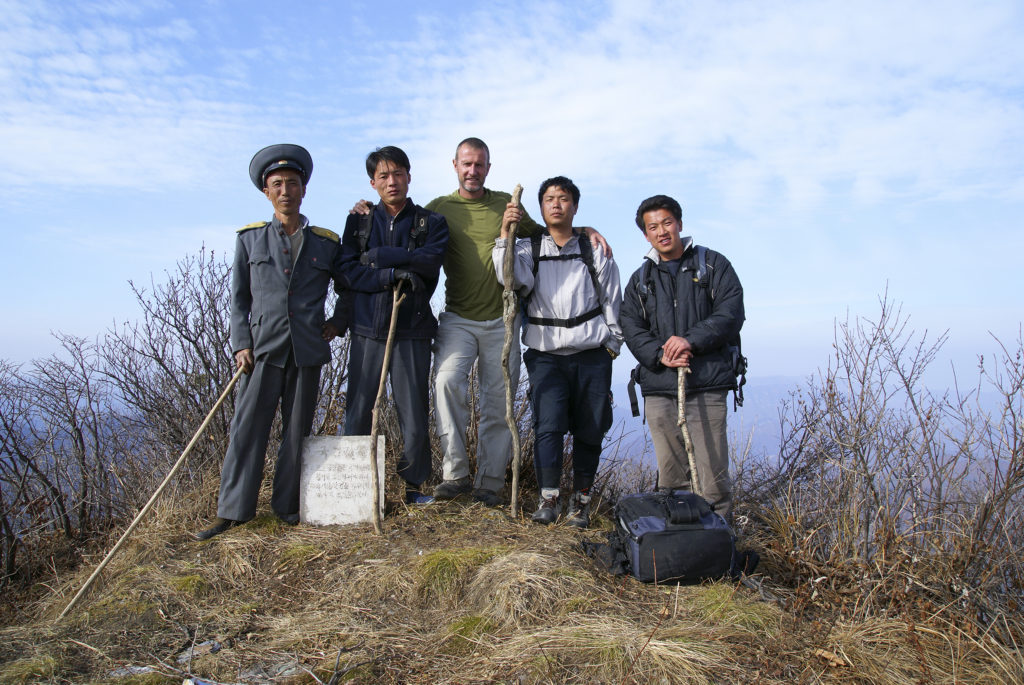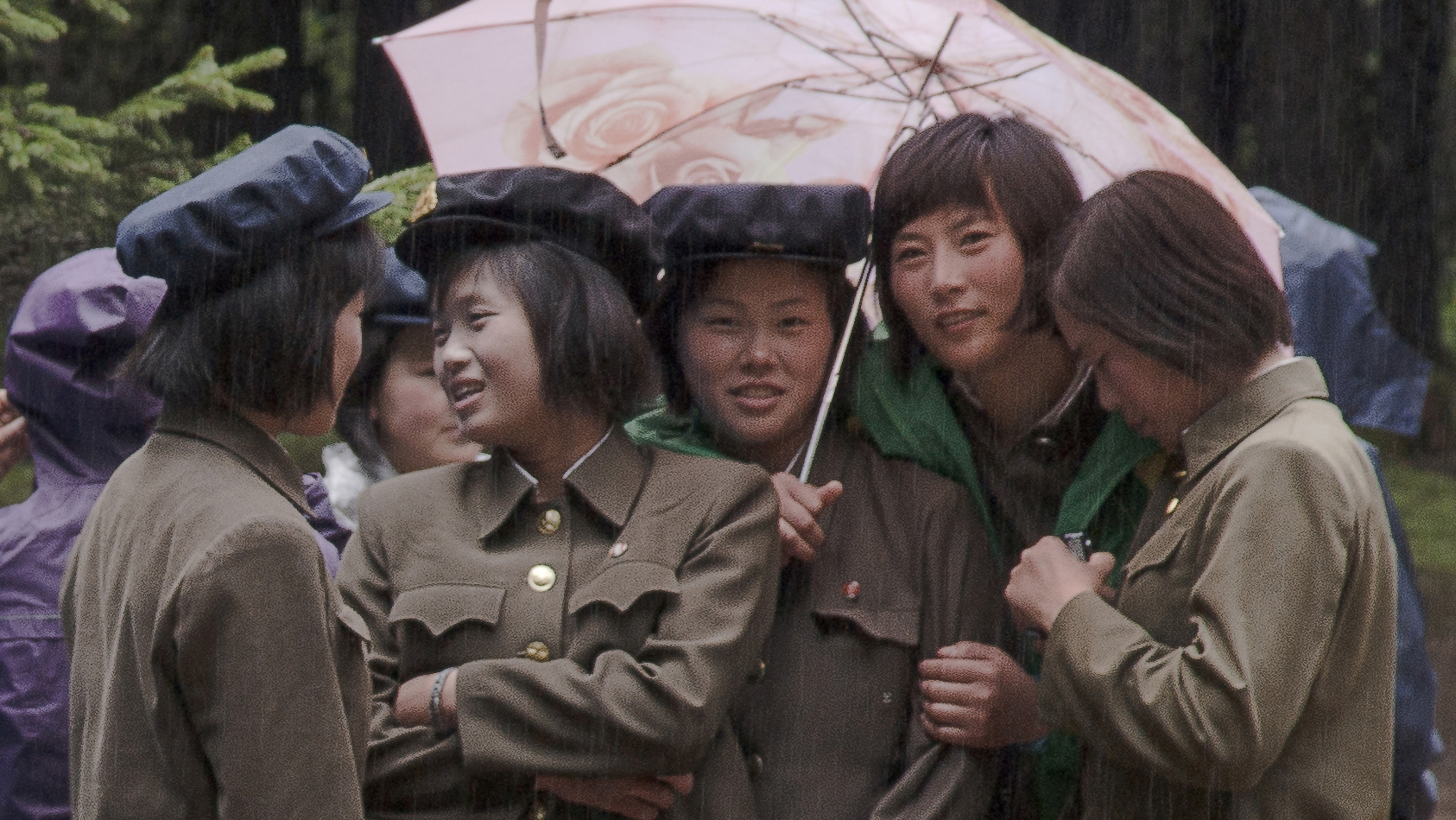The Baekdu Daegan (백두대간) as a Symbol of Unity
Written and photographed by Roger Shepherd
A thin red line squiggled its way up a map of the Korean Peninsula, coursing over what looked like most of its jagged terrain. “What the hell’s that?” I asked. “That’s the Baeekdoo Daeegann, mate!” Andrew replied in a thick Kiwi accent. “I’ll geev ita go thyn, aye?” I instantly said in mine.
It was 2006, and I was in Korea on a visit. The plan was to hike its national parks, but their marked trails now seemed dull compared to what I had just discovered. Carrying only a large sheet map that I had stolen from a bus terminal’s wall, the Hangeul peak names of the Baekdu Daegan had all been scribbled back into English, so as I loped along from peak to peak for the next two months, I could at least try to pronounce them.

Korean hikers would stop me, and those who spoke some English would ask me in their structured way where I was going. “I’m hiking the Baekdu Daegan,” was my reply, spoken in an easy-to-understand American drawl. A lump would form in their throats, followed with some splutters, as they struggled to find a response. Instead, the Korean hiker would remove his pack, summon me to do the same, and on that sunny ridge, we’d take a seat on a nearby rock – this is how I began my first lessons on Korea’s Baekdu Daegan. It seemed I was the first foreigner to be hiking its unknowns.
I was not just roaming on a long ridge that charmed its way through rural Korea, but as I found out through Korean hikers, I was on the highest crest of a more extensive intravenous network of ridges that splayed out all over Korea and fell into the sea. For those Baekdu Daegan hikers I met, it was part of their pilgrimage to be more Korean.

By the time I had finished that stroll way back in 2006, I was ready to do it again. I returned in 2007. This time I had to record it and make it available to others. I decided to write a guidebook (published in 2010) on how to hike the 687-kilometer continuous ridge called the Baekdu Daegan in South Korea. During the process of making that first edition, a whole new Korea opened up to me. Korea was a land deeply immersed in a mountain culture that dated back to pre-history. It is a nation riddled with peaks, each one with a mountain spirit. Its dynasties were defined by mountain ranges that saw pitched battles at most of the fortressed passes. Mountain tales exist of fairies, imps, serpents, and extraordinary feats of Daoist, Buddhist, and Confucian sages. Meanwhile, the ridges of Korea emitted natural energies called pungsu-jiri, the origin point of which was Korea’s highest and holiest peak, the sacred Mt. Baekdu (백두산, 2750 meters). From there, these energies transmit along the Baekdu Daegan, like a central nervous system thrumming inside a skeletal spine, and then pump farther and deeper into the landscape and the people via the wavy labyrinth of subsidiary and lesser ridges of Korea. As Kim Jong-il once wrote, “Korea is a 3,000-ri (a Korean land measure) golden tapestry linked with the same mountain range.”
On a divided peninsula, the Baekdu Daegan runs 1700 kilometers down its entire length. It is never cut by water, augmenting it as the watershed of the whole nation.
In 2011, I made my first trip (one month) to North Korea to begin my expeditions of the Baekdu Daegan there. I planned to photographically document as much of it as I could, so as to make photo art books on this “Great Ridge” (Daegan). I returned in 2012 for six weeks, and although I made several other unrelated visits to the North each year after that, I made my next big expeditions again last year (2017) two times, totaling ten weeks of exploration. My visits always took me deep into the valleys and peaks of remote rural North Korea. We slept out in tents; ate local foods like free-range rabbit, pig, duck, chicken, river fish, honey, mountain vegetables, potatoes, and rice; drank local varieties of soju; and took our water from and washed naked in the chilly valley streams. I formed friendships.

My work saw me publish two editions (2013, 2015) of Mountains of the Baekdu Daegan from North and South Korea, and another, upcoming edition this year (2018). My photo art books identify the Korean people as one people sharing the same landscape and mountain system in the Baekdu Daegan – the peninsula’s biomorphic spine, which, despite the tourniquet of barbed wire that crimps its torso, still connects both sides as a country, and still pulsates a natural energy throughout.
I have been based full-time in South Korea since late 2010. Since then, I have made at least a dozen visits to North Korea and have been involved in numerous projects and exhibitions on Korean unity, using the Baekdu Daegan as a symbol of that. I have found the Korean people, despite differing political ideologies, to be substantially the same people with the same mannerisms. Notably, they also share the same admiration for their mountains, in particular, the Baekdu Daegan, which symbolizes to them their whole mountainous nation. Mt. Baekdu in the far north is their grandfather mountain, and in the far south, Mt. Halla (한라산) is their grandmother mountain. All the peaks in between are part of the larger family of mountains that form the Korean family. I hope one day the Baekdu Daegan can reconnect the Korean people.
Note: To hike the Baekdu Daegan in South Korea, you can purchase an updated 2017 copy of the guidebook at www.hikekorea.com.
THE AUTHOR
Roger Shepherd is a New Zealander residing in the Jiri-san mountains with his own registered company, HIKEKOREA. He runs guided mountain treks for visiting foreigners, is an exhibited photographer, and is also a published writer. His work discovers Korean identity through the mountains. In his spare time, he likes to sleep on off-the-beaten-track peaks with a bottle of makgeolli.





